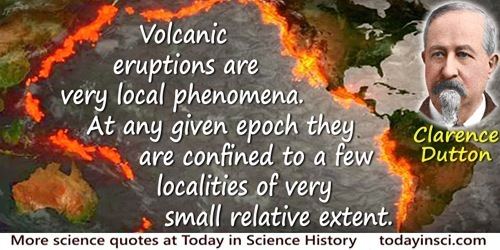Nationality United States | Name Clarence Dutton | |
 | ||
Books Tertiary history of the Grand Cañon District Education Yale College, Yale University | ||
Clarence Edward Dutton (May 15, 1841 – January 4, 1912) was an American geologist and US Army officer. Dutton was born in Wallingford, Connecticut on May 15, 1841. He graduated from Yale College in 1860 and took postgraduate courses there until 1862, when he enlisted in the 21st Connecticut Volunteer Infantry; he fought at Fredericksburg, Suffolk, Nashville and Petersburg.

In 1875, he began work as a geologist for the U.S. Geological Survey. Working chiefly in the Colorado Plateau region, he wrote several classic papers, including geological studies of the high plateaus of Utah (1879–80), the Cenozoic history of the Grand Canyon district (1882), and the Charleston, SC earthquake of 1886. As head of the division of volcanic geology at the USGS, he studied volcanism in Hawaii, California, and Oregon; his studies of basaltic lava flows in Hawaii led him to introduce the native Hawaiian language terms "ʻaʻā" and "pāhoehoe" for cool, clinkery lava flows and smooth, billowy lava flows respectively. He helped coordinate the scientific response to a large earthquake in the Mexican state of Sonora in 1887. He was elected a member of the National Academy of Sciences in 1884.

In 1886, Dutton led a USGS party to Crater Lake, Oregon. His team carried a half-ton survey boat, the Cleetwood, up the steep mountain slope and lowered it 2,000 feet (610 m) into the lake. From the Cleetwood, Dutton used piano wire with lead weights to measure the depth of the lake at 168 different points. The survey team determined the lake was 1,996 feet (608 m) deep. The currently-accepted maximum depth figure, measured by sonar, is 1,943 feet (592 m).

In 1889, Dutton proposed the term "isostasy" for the concept of a general balance within the Earth's crust, with lighter weight blocks coming to stand higher than adjacent blocks with higher density, an idea first expressed by Pratt and Airy in the 1850s.

Dutton was a close associate of John Wesley Powell, G.K. Gilbert, and William Henry Holmes at the USGS. He was an energetic and effective field geologist: in 1875-1877 Dutton's field party mapped 12,000 square miles (31,000 km2) of the high plateaus of southern Utah, an area of rugged topography and poor access.

Dutton had a distinctive flair for literary description, and is best remembered today for his colorful (and sometimes flamboyant) descriptions of the geology and scenery of the Grand Canyon region of Arizona. "Dutton first taught the world to look at that country and see it as it was... Dutton is almost as much the genius loci of the Grand Canyon as Muir is of Yosemite" -- Wallace Stegner, Beyond the Hundredth Meridian.
In 1891 he retired from the USGS to serve as commander of the arsenal of San Antonio, Texas; then as ordnance officer of the department of Texas. After retiring from the Army in 1901, he returned to the study of geology. Dutton spent his last years at the home of his son in Englewood, New Jersey.

